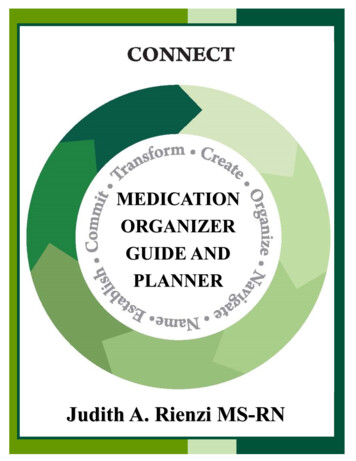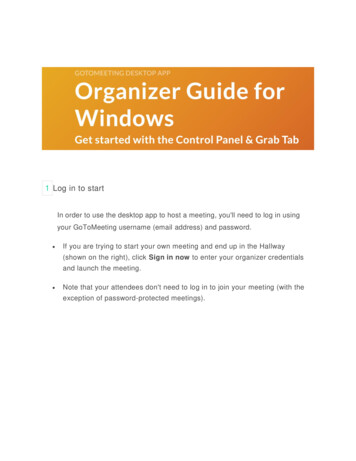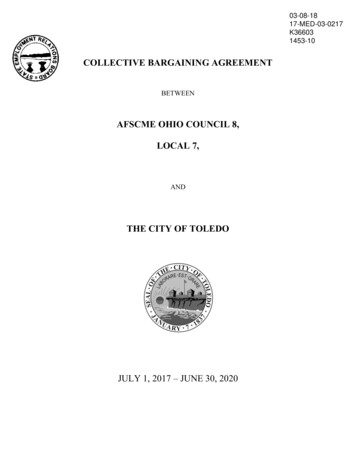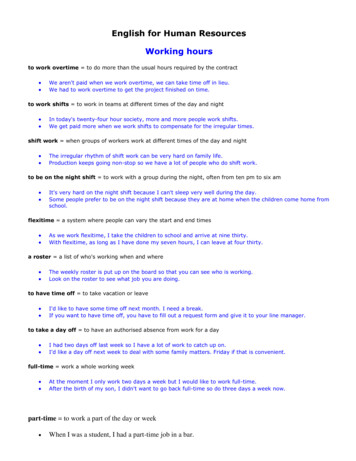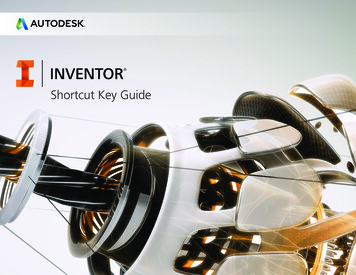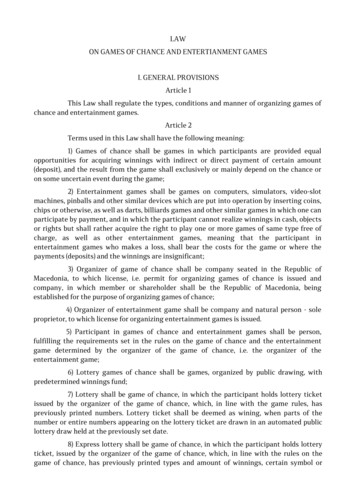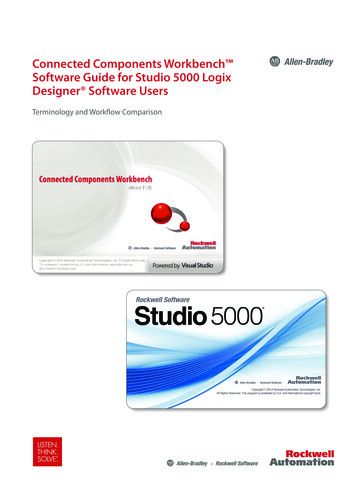
Transcription
Re TalentsponsibilityCom OytinrtuHard WorkmArofgnitFighssalCgnikerica’s Wor1
Dear Sisters and Brothers,Congratulations, and welcome to the AFSCME family!AFSCME has a long history of stepping up when workers need to fight hard. We are in one ofthose moments in history right now. AFSCME has the resources and strength to rebuild apowerful labor movement. That’s why our union’s number one priority is organizing.But let’s be honest: Organizing isn’t easy. It takes courage to stand up for our rights on thejob. It takes lots of one-on-one conversations at work and at home to build our organization.It takes talented and committed organizers who know the ropes and are willing to work hard.Organizing may not be easy, but it is crucial in our fight for fairness. Seize this great opportunity, this great responsibility and run with it. Working families across this country need you.You are joining a long legacy of AFSCME organizers, men and women who built this unionbrick by brick, worker by worker. These are big shoulders to stand on. Do them proud. DoAFSCME members proud. Do yourself proud.In solidarity,Lee SaundersElissa McBride
Table of ContentsWelcome to AFSCME.1The OIA & OIT Experience. 2How to Use This Book. 6The Organizer Development Program Basics.7The 9 Core Skills of a Successful Organizer. 8Organize: Move Workers One-on-One .15Figuring It Out: Assessments & Debriefs. 19Learning & Growing: Feedback . 23Leadership Makes All the Difference: Building the Committee. 27Building Blocks: Information Management.29Turning Points: Meetings & Actions. 33Vision: Message & Communications .39Putting It All Together: Campaign Strategy . 43Stewardship: Good Work Habits. 47ADDITIONAL RESOURCESBlank & Completed Core Worksheets . 54Feedback Forms .62One-on-Ones.62Running Meeting & Actions.63Tips for Preparing for Your Evaluation.65Organizing Model.66GLOSSARY OF COMMON TERMS. 67
Welcome to AFSCME!Union organizing is like no other job, and atAFSCME, we find and develop the best organizersin the country. It’s safe to say that you’ll come outof this year a changed person.This book will help you navigate the waters oforganizing for your first year. It will tell you what to1expect and what is expected of you. You’ll be givenopportunities to develop your skills in the field, atclassroom trainings, at debriefs, and through conversations with your lead and fellow organizers. It’sup to you to make the most of these opportunities.The program outlined in this book will help youlearn and grow and give you the tools to succeed.
rtatSreeHTheORGANIZINGInstitute Apprentice ExperienceThe AFL-CIO Organizing Institute Apprentice (OIA) training is a 12-week programthrough which participants learn the basics of organizing while working on a campaign.The OIA period gives everyone involved the opportunity to see if this is the right fit – tomake sure you have what it takes to come on staff as an Organizer in Training (OIT), butalso to determine if union organizing is something you want to pursue.During this period, focus on the basics of the campaign and how we organize. Here’s yourpriority list:Organize workers one-on-one: Learn the five steps of effective housecalling and other one-on-one discussions with workers who are organizing their unionwith AFSCME.Background, facts and message of your campaign: Why areworkers organizing? How will they win? Why is this campaign important to AFSCMEmembers?“Ride-alongs” with experienced organizers: Try out your newskills, get feedback and incorporate it successfully into your work.Debriefs: Show you can discuss one-on-one conversations you had.Recountspecifics like the motivation, issues, job duties and information about the workplace,coworkers and supervisors. This is also an opportunity to discuss any “roadblocks” youencountered in the conversation, brainstorm different approaches and role play effectiveways of overcoming those obstacles.2
MONTHMONTHMONTH12312 WEEK PROGRAMBest Advicefrom Successful OIAs“Look at everything as alearning opportunity.”“Ask questions! Don’t try and fake it.Ask LOTS of questions!”“When the lead is looking for people to cover the6 a.m. shift change, Volunteer! Get as muchexperience as you can.”“Identify the organizer with a positive attitude,who’s working the hardest, being the mostsuccessful, and contributes the best ideas tothe team. Hang out with them!”“Don’t get lost in the crowd. Ask forattention, show what you are learning.Prove you can and want to be the next bestAFSCME organizer.”33
The Organizer inTRAININGExperienceCongratulations, you are now an AFSCME Organizer-inTraining (OIT), and have become part of a very specialgroup of activists! With your new title, you will still needto complete a nine month probation, with trainings,evaluations, ride-alongs and added responsibilities.The OIT period (combined with the 12-week OIA) is aone-year probationary training program in whichyour job is to focus on learning the basics of thecraft of organizing and demonstrate that youare an effective organizer. You will be assigned to one or more campaigns in whichyou will be required to learn new skillsand demonstrate them.44
CongYo u’reMONTH456789ratulatan AFions!SCMEOrganizer1011Here’s what to expect while you are an OIT: Skills Development Check-Ins: You will be assigned an experienced organizer who will meet with you every few months to check in on your development and helpyou focus on the skills and habits you need to be successful. AFSCME Organizer Training School (AOTS): This is an intensivetwo-and-a-half day classroom training that focuses on effective one-on-one communications; leadership recruitment and development; the AFSCME organizing model andcampaign strategy. Embrace this as an opportunity to learn new skills, practice them,make mistakes in a safe environment and offer constructive feedback to your fellow participants. National Union Orientation:AFSCME is a large organization, and unionsare heavily regulated by the government. As such, you will be expected to fill out a lot ofpaperwork including your new hire forms, weekly attendance, travel and expenses. Thisorientation will help you navigate the paperwork, as well as offer you a chance to learnabout our union’s history and structure. Blitzes: A blitz is what we call an intense, often quick, period of a campaign. Usually,organizers and volunteer member organizers are brought in from other campaigns to helpreach as many workers as possible in a short amount of time. Blitzes are fun, exhaustingand a great learning experience for new organizers. Working with Union Leaders: AFSCME is proud to be a democratic, mem-ber-led union. You will have the opportunity to work with members at a variety of levels —sometimes this means working with local leadership, organizing committees or volunteermember organizers (VMO). Written Evaluations: from a manager mid-way through your OIT, and againtoward the end of your OIT.512
se This BookUotwoHOrganizing is both an art and a craft. Part of becominga good organizer is learning the mechanics (the craft) while also understanding interpersonal dynamics (the art). The craft of organizing can belearned in the classroom, through debriefs, and manuals like this, while theart of organizing can only be learned by years of hands on experience in thefield.Start by taking a look at the Core Skills Worksheet on page 54. These arethe fundamental skills that you need to be an effective organizer. Thisworksheet is designed for you to use with your assigned trainer in regularmeetings every three months.Each core skill has its own chapter. In each chapter you will find a summaryof the skill broken down into the behaviors and habits you will be expectedto demonstrate to show that you have mastered organizing basics. Alsoincluded are tips to help you learn and show that you are proficient in thatcore area.The Additional Resources section in the back of this book includes the blankcore skills worksheet, a completed sample, feedback forms, tips for preparing for your official evaluation, and the AFSCME Organizing Model. Finally,there is a glossary of common terms.AFSCME is committed to finding and developing the best organizers in thecountry and this book is an important part of that commitment. No programor organizer, however, can make you learn and grow as an organizer. TheAFSCME Organizer Handbook is your tool for learning through experienceand the experience of others. Use it!66
The OrganizerDEVELOPMENTProgram Basics77
The9 CORE SKILLSof a Successful Organizer1. Organize! Move Workers One-on-One2. Figuring It Out Assessments and Debrief3. Learning & Growing Feedback4. Leadership Makes All the DifferenceBuilding the Organizing Committee5. Building Blocks Information Management6. Turning Points Meetings & Actions7. Vision Message & Communication8. Putting It All Together Campaign Strategy9. Stewardship Good Work Habits8
OrganizerDEVELOPMENTMeetingsOrganizer development meetings are resources for you to check in with andutilize more experienced organizers to help you improve your skills. Thisprogram is designed for three check-ins.Before each meeting reflect on your work and fill out your strengthsand weaknesses in each of the core skills. Include examples of where youdemonstrated (or didn’t) the skill. After you have completed the sheet use thesummary box to summarize what you think you are doing well and what youneed to focus on. A thoughtful self-analysis of your own work will help youhave a productive meeting with your assigned trainer. He or she will do his orher own analysis of your work.During the meeting discuss each core area and decide together onyour priority areas to work on in the upcoming months. Develop a plan fordoing so with concrete and specific goals to advance your skills. These shouldbe incorporated into your weekly plans.99
The Organizer inTRAININGYear TimelineOIA Month 1 Review the Core Skills Worksheet and write down any questions you have Ride-alongs with organizers and managersOIA Months 1-3 Ride-along with a member of the staff development team Written ride-along feedback from another organizer on the campaign Attend AOTSMonth 4: First Month of OIT Read the Organizer Handbook Complete the core skills worksheet and schedule your firstdevelopment meeting with your mentor Ride-alongs with organizers and managersMonth 5 Ride-along with written feedbackMonth 6 Ride-along with written feedback Use evaluation tips in Additional Resources to prepare Official evaluation with manager10
Month 7 Ride-along with written feedback Complete the core skills worksheet and schedule your second development meetingwith your mentorMonth 8 Ride-along with written feedbackMonth 9 Ride-along with written feedbackMonth 10 Ride-along with written feedbackUse evaluation tips in Additional Resources to prepareOfficial evaluation with managerComplete the core skills worksheet and schedule your third development meeting withyour mentorMonth 11 Ride-along with written feedbackOne Year: Final decision about promotion to Organizer.1111
12
CORESKILLS131313
1414
Organize!Move Workers One-on-One4 Understands the steps of the agenda and consistently followsothe agenda in conversations.4 Identifies motivation after every conversation.o4 Speaks credibly and inspirationally about the union andocampaign vision.4 Inoculates effectively.o4 Agitates around issues and the need for action.o4 Gets commitment.oGreat organizers are greatobservers. Always think about who’stalking to whom, who’s in the room, where doworkers hang out, who’s driving what, who saidwhat. Take notes. Seize opportunities.1515
The “one-on-one” is where the most importantwork of organizing gets done. Great one-on-onesare about your ability to relate to workers, bedeliberate and skillful and get results.Know It & Show It Practice! Get face-to-face with a lot of workers every week. This is the mostimportant part of your job. What are you doing and why? Make sure you can explain it.- What are the steps of the agenda and why are they important?- What’s the message on the doors? What’s the inoculation?- What did you do in the house visit that made a difference and why did you do it?- What didn’t you do that you wished you had? Prove it!Ask for experienced staff and campaign managers to ride-along withyou and prove you can get in the door, consistently follow the agenda, tackle toughsituations, ask the right questions and move workers to action. Use role plays to show you know the basics and that you can identify yourweaknesses. Track your numbers. How are you doing with sign-ups, petitions, turnout? Observe others and explain what specific things the organizer did that madea difference moving the worker. Is there an opportunity he missed or something youwould have done that could have improved the visit?Analyze your results and get specific about what you can do to improve. Use debriefs to show you are being successful and have a plan.- Determine support or opposition to the union in terms of what they said,actions they take, and an understanding of their motivation.- Talk about who the worker knows, the relationships and how she fits into thenetwork of leaders.- Be clear about what opportunities you may have missed and talk aboutspecific follow-up that’s needed, if any.16
Assess andMove to ActionStep 5.InoculationStep 4.VisionMessagePlan to WinStep 3.Get the StoryStep 2.IntroductionStep 1.StepAlways agree on a specific follow-uptime within a couple of days to checkback and see how they did with theirassignment.If the worker hesitates, ask what isholding them back? Then go back totheir concern and agitate.“Are you ready to join with yourcoworkers to organize your union?”Assess the worker’s support and willingness to get involved. This iswhere workers must clearly understand they are making a CHOICE– to work to make things better or to let things stay the same or getworse. We assess workers based on their support for the union.In any campaign, workers have to take action to build their union.There are many actions they can take. Sign a card, contact otherworkers, house visit with organizers, sign a petition, give a pictureand quote for literature.Identify the employer’s most effectivetactic and develop an inoculationbased on that.This step is about painting a pictureof how a worker comes together withhis/her coworkers to address themost important problem he/she identified. This is also where the organizerdoes the most talking. In this part ofthe housecall, the organizer shouldhave a clear detailed description ofwhat it will take to build the union.Ask fact based and open ended questions. Look for facial and verbal cuesto ask follow-up questions.To engage someone who is reluctant,begin the conversation with questionslike: How long have you been there?What do you do? Then ask to comein again.Helpful Tips“Is there anything that you think will getin the way of you and your co-workersorganizing the union?”End Step 3 with the question:“Does that make sense to you?”“What would happen if you wentinto your boss’s office and told himthat ?” and then “Whatdo you think would happen if 300of your co-workers went in and demanded your boss do something about? Do you think if wouldmake a difference?”#2 Then, “Do you know howwould be different if youand your co-workers had a union?”“I’d like to sit down with you to learnwhat you think about ”“May I come in?”Transition QuestionWe prepare workers for what the boss may do and say to fight theirefforts to organize. We may also inoculate them on such things asanother union or anti-union coalitions.In the second part of the Step 3, we give them the one sentencesummary purpose or message for the campaign here and the planto win.With a second transition question, we create a vision of the unionby discussing how his/her particular concern could be different ifthey organized a union.First, we create a vision of the union, the individual powerlessness vs. collective power. We do this by asking the worker thesequestions. (After we have demonstrated the powerlessness of theindividual vs. collective, we move to the next transition question.)We get to know the worker, hear about what work is like for them,what they think could be better. We also get to know how theirconcerns at work affect them and their families.Clearly state who you are, where you are from, and why you arethere.Purpose of StepSteps of the Housecall17
181818 18
Figuring It OutAssessments & Debriefs4 Accurately assesses workers and defends assessment.o4 Uses AFSCME assessment system correctly.o4 Utilizes assessments strategically to prioritize and plan work.o4 Thoroughly and accurately debriefs conversations.o4 Identifies specific things that would have improved the visit.oIf someone tells us he willvote yes but won’t sign thevote yes petition, will hesupport the union? No. If a workeris unwilling to publicly commit, he is unlikelyto vote for the union especially if there is aboss fight.1919
Accurate assessments and detailed debriefs arehow we build a strong union that can mobilize toexercise power. These tools depend on thoroughone-on-one conversations and inform strategicdecisions that help us win.Know It & Show It Explain the assessment system to others and why it’s important. Accuracy.- What are the concrete measures that separate Organizing Committee from supporters?- YES votes from undecided?- How do we define a GOTV universe?- Describe relevant tests that support the rating system.Your assessments are backed up with concrete observations. You consistently predictoutcomes of votes, petitions and turnout. Assessments must inform your daily work.- Detailed daily debrief.- Weekly planning and reporting.- Explaining strategic choices.- Keeping charts and database updated. Be prepared- Know your numbers and be ready to describe your turf in terms of total universe,breakdown of assessments, including number of unassessed.- Be consistent with complete notes and debrief sheets on a daily basis.- Show that you can thoroughly and accurately debrief conversations.- Identify specific things that you could have done that would have improved the visit. Actively participate in group debriefs and take notes.20
Daily DebriefsIn addition to informing your turf strategy, campaign strategy and message, dailydebriefs can be an incredible tool to help you learn the art and skill of organizing.Here are some tips to help you maximize your debriefs:4oHave all contact sheets and daily debrief forms completed BEFORE you sit down to debrief.4oPay attention to what numerical information your lead and director want you to report.4oReport any information that is new or hasn’t come up before in the campaign.4oBe prepared to walk through every step of the visit.4oFocus on what the worker said and how you responded, not how you felt.4oDefend your assessments with specific backup of what the worker said.4oBe prepared to explain what you did well and what you could have done differently.4oResist making assumptions or ascribing your own fears or hesitations in explaining theworkers’ motivations.4oHave a follow-up plan or path forward for each potential leader that you assessed.4oIdentify challenges you had in the field, and get ideas for how to overcome them.4oTake note of what questions your lead/director asked that did not have answers and makesure you get all that information the next time.4oAssess how you met or fell short of your goals for the day, and how it changes your daily,weekly or turf plan.21
The AFSCME Assessment SystemThe assessment system is an organizer’s road map. Assessments summarize where anindividual worker stands on the union, show where a group of workers stand collectively, andform the basis for strategic decisions in the campaign. Assessments help you plan your workby giving you a picture of the support, opposition and possibility for growth in your turf.Workers’ assessments change throughout a campaign based on different ‘tests’ andbenchmarks. Accurate assessments are critical to the success or failure of your campaign.AFSCMEASSESSMENT SYSTEM1. Committee Demonstrated they lead and move others in support of the union.For instance, they have signed others on cards, recruited others tomeetings, and helped undecided coworkers overcome concerns.2. Solid Union Supporter Passed every test. If the election were today 2s would vote yes.3. Undecided or Movable May have expressed support, passed some tests (ex., signed a card). Must have issues on which we can agitate, but still has concerns/questions/fears. Our strategy should be centered on moving the 3s.4. Not Supporting the Union Not only those who tell us they don’t support the union but thosefor whom there is no clear path to move them to support.22
Learning &GrowingFeedback4 Seeks out advice from others on ways to improve skills.o4 Incorporates specific feedback.o4 Gives accurate and concrete feedback to otheroorganizers and VMOs.Why do we sign membershipcards instead of authorizationcards on organizing campaigns?A membership card is a commitment to buildingthe union. It gives us stronger assessments andgives workers ownership in the outcome.2323
We have important work to do and precious resources to accomplish our mission. We need to beat the top of our game to win. Think critically aboutyour work and the campaign, and develop habitsthat lead to learning and doing your best work.Know It & Show It Seek it out! Asking for feedback shows you want to improve. Make it a habit.- After home visits- During group debriefs- Approach the most successful organizer on the campaign for advice- Request time with your lead and campaign manager- Anytime you go to a new campaign Accept it! Use it!Accepting feedback shows you are willing to learn new skills. Listen, askquestions, ask for examples. Don’t argue or be defensive.Incorporating the feedback shows that you can improve and that you arelearning.- During a ride-along, incorporate feedback into your next home visit.- Be prepared to describe feedback you got and what you did differently andthe results.- When someone comes to observe your work, be prepared to talk about what skillsyou are focusing on.- Articulate your strengths and weaknesses on the core skills worksheetand give concrete examples to back it up. Give constructive feedback to others.- Consistently participate in debriefs, staff meetings and one-on-one conversationswith peers and new organizers and show that you can think critically.- Feedback reflects the principles and practices in the organizing model.- Analysis is backed by concrete examples.- Communicate in a way that supports the development and learning of others.- Describe the best practices of debriefing and giving feedback.- Give examples of feedback you have given others, why it wasimportant and the impact it had.24
Tips for FeedbackLearning to give effective feedback hones your critical thinking skills and will help you andothers get better at what you do. Listen Critically.Listening to someone else house visit is a great opportunity tothink about ways to improve the visit from which both observer and organizer can learn.As the observer, the pressure is off and you can watch the conversation, listen for detailsand think ahead. Focus on tangible things the organizer did to affect theoutcome. Outcomes are important but we learn by understanding how we got there.We can’t control people’s attitudes, how busy they are, their past experiences, but we cancontrol what we do in any given situation. Ask Questions. Start out by asking the other person to critique themselves. Mostpeople are more critical of themselves than others and will no doubt raise any big snafus.This can help you prioritize what you want to say. You may even have a different perspective to offer as the observer. Walk through the visit step-by-step. This is the simplest way to organizeyour thoughts after observing someone home visit. For each step of the agenda: Did youaccomplish the objective? What did you say? What got in the way? What else could youhave done? Don’t wait. Effective feedback comes when the experience is fresh in the mind of theobserver and organizer. Prioritize. If you feel like everything was awful or it all was great, you need to pri-oritize what you want to say. One way to do this is to follow the order of the house call. Ifsomeone is having trouble getting the motivation, they will not be able to agitate effectivelyaround the commitment. Be specific about what works. Identify what the organizer did or said thatmade a difference. This allows you and others to repeat what works. “You did a great jobmoving her to become a member” makes people feel good but does not explain what exactly the organizer did that made her successful. When you identify a problem or something to improve –offer concrete alternatives. Don’t raise a problem without a solution. Alwayssay “Instead of doing X, try doing Y.” This gives the organizer something concrete to dothat is within her control and gives her the benefit of what you have learned.25
2626
LeadershipMakes All theDifferenceBuilding theOrganizing Committee4 Accurately identifies natural leaders and activists.o4 Gives appropriate assignments and motivates leaders toocomplete them.4 Develops leaders around campaign message, goals, plan andoeffective one-on-ones.4 Creates development plan for each leader.o4 Recruits a representative committee of appropriate size.oLeaders have followers.Activists do the work but can’t moveothers. Always strive to recruit thenatural leaders in a workplace, even ifthey are initially anti-union. Prioritizethe real workplace leaders, if you don’tyou will lose.272727
Credible leaders are the face of the union, the key towinning campaigns and building sustainable organizations. It is your job to identify, recruit and developworkplace leaders who learn how to organize and cancommunicate a vision for their union.Know It & Show ItKnow the difference between natural leaders in theworkplace and pro-union activists. Apply this knowledgeto your strategy and daily work. Assess your turf in terms of strengths and weaknesses in leadership. Reflect this assessment in you weekly goals, plans, reports. Daily debriefs and weekly plans consistently reflect goals and activity of leaders. Charts and database accurately reflect leadership. Evaluate your committee’s individual strengths and weaknesses and identify appropriate goals and next steps. Be prepared to describe an individual that you developed as a leader, steps youtook. Show that individual leaders are successful at moving the campaign forward. Understand the role of the organizing committee and lead that committee. Explain andteach others what makes a good organizing committee and its role in the campaign. Demonstrate how to prepare for a first committee meeting and the strategic decisionsinvolved. Have a plan and goals around creation and development of the committee. Draft an agenda that is appropriate to the phase of the campaign. Show that you can successfully lead a committee meeting. Demonstrate the skills to successfully train leaders in groups and one-on-one. Be prepared to give examples of how you moved the committee around a campaigndecision, the obstacles, and what you did to be successful. Leaders understand the strategy and plan for the campaign and have ownershipin the decision making and execution.28
Building BlocksInformation Management4 Builds worker lists quickly and resourcefully.o4 Uses updated, accurate and complete worksite charts,odatabase lists and housecall sheets to plan work.4 Maintains records, housecall sheets etc., in orderly manner.o4 Uses maps and charts to plan work.o4 Uses database to update and retrieve data.o4 Turns in accurate and complete reports.oNever hold an OrganizingCommittee meeting withoutorganizing tools. B
HANDBOOK e ts ty t ty k t ica’s orking Class. Dear Sisters and Brothers, Congratulations, and welcome to the AFSCME family! AFSCME has a long history of stepping up when workers need to fight hard. We are in one of those moments in history righ



